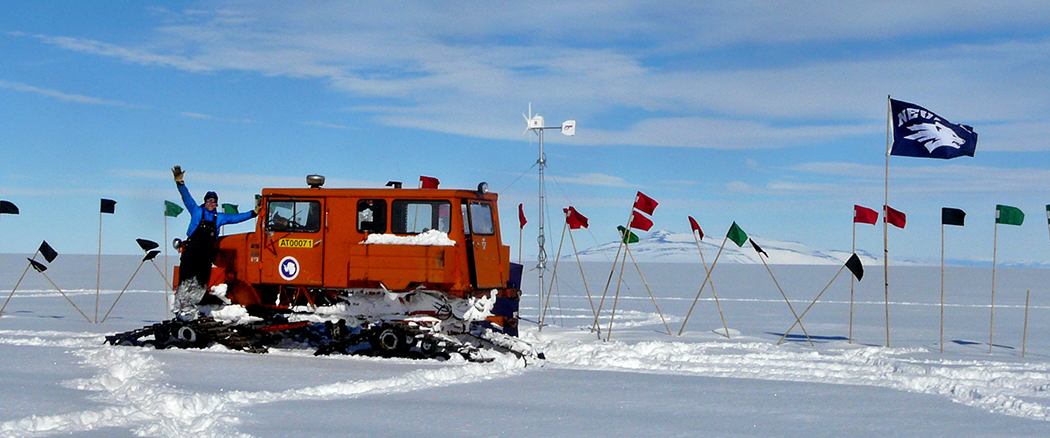For the first time ever, scientists have recorded temperatures continuously at the bottom of an Antarctic ice shelf where warmer sea water threatens to erode the massive ice which, if it collapses and glacial melting occurs, could cause a three-meter rise in ocean levels around the world.
"This is the first time we can see the changes in the melting of these enormous ice shelves daily and at millimeter accuracy," Scott Tyler, professor of geosciences at the University of Nevada, Reno, said. "This is critical for detecting the changes that may be occurring due to climate change."
Tyler and his research team dropped a 3/4-mile-long fiber optic cable through the Ross Ice Shelf and into the frigid sea waters below. The armored cable, when combined with a laser, acts as a thermometer. It recorded temperatures every meter along its length every two to four hours, continuously 24/7 for 14 months. The change in temperature at the sea/ice interface indicates the thickness of the icepack as warm wind-driven waters eat away at the bottom of the ice shelf.
"The ice shelves serve as the 'corks' holding the large glaciers of west Antarctica from sliding into the ocean and raising the sea level," he said. The Ross Ice shelf is the world's largest body of floating ice, the size of France, on the Pacific Ocean side of the continent.
After nearly three years of preparation, implementation and data gathering from one of the harshest environments on earth, Tyler is pleased with the data gathered from the fiber optic cable that is encased in 200 meters of sea ice and hanging 600 meters to the bottom of the ocean at McMurdo Bay on the McMurdo Ice Shelf, a subsidiary of the Ross Ice Shelf.
"We were getting data downloads here at home eight times a day and the system recorded and sent temperatures and pressures perfectly," Tyler said. "Our goals are to show that we can install these monitoring systems quickly and inexpensively, and then provide continuous data via satellite links throughout the long Antarctic winter.
Tyler, a hydrologist in the University's College of Science, said the objectives of this first season of field testing were to test the drilling design, test the fiber optic installation and sensing, and test the logistics of continuous monitoring and power system development for continuous operation in the harsh Antarctic climate.
"The system can give the world relevant data on sea and ice temperatures for tracking climate change and its effect on the glacial ice surrounding the continent," Tyler said. "We do show warming of the shelf, and seasonally, but it is only the first year of data. It will probably take a few years to get a more continuous picture and we are proposing to expand our monitoring network to do just that."
The site on the McMurdo Ice Shelf was chosen for the research to provide realistic ice sheet thickness, sufficient ocean depth and ease of logistics to adequately test power supply viability and data communications. Tyler worked with a team of researchers at the desolate spot about 25 kilometers from the McMurdo Station research outpost. Members of the team working with Tyler on the expedition were David Holland, an oceanographer at New York University; Victor Zagorodnov, a glaciologist at The Ohio State University and Alon Stern, a graduate student at New York University.
Tyler pioneered the fiber optic distributed temperature sensing systems for academic research six years ago. From the coldest to the hottest places on earth, he and other U.S. researchers have since used innovative fiber optic/laser technology to take temperatures in a variety of hydrological, climatological and geological topics such as to study glaciers, caves, creeks, mines, avalanche areas, volcanoes, farmlands and even water temperature at Devils Hole in Death Valley to help protect the endangered pupfish.
The fourth scientific paper from this ice shelf research has just been published in the Oct. 16 issue of Geophysical Letters and was based on the Master's thesis of University of Nevada, Reno graduate student Scott Kobs, who came up with the concept of using the temperature gradient in the ice shelf to monitor its melting very precisely. Kobs is the lead author on this paper and just completed his master's degree in hydrology. The journal Science featured a story about the research on its daily science website and the Voice of America radio program reported on the findings as well.
The Antarctic study, based at the University of Nevada, Reno, is funded by the National Science Foundation's Office of Polar Programs and other NSF grants.
For more information about distributed temperature sensing and its worldwide use to monitor the earth's temperature, visit www.ctemps.org.












